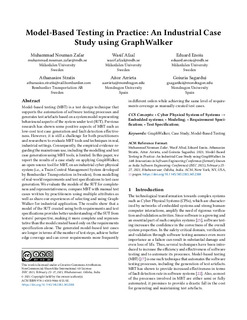| dc.rights.license | Attribution-NonCommercial-ShareAlike 4.0 International | * |
| dc.contributor.author | Arrieta, Aitor | |
| dc.contributor.author | Sagardui, Goiuria | |
| dc.contributor.other | Zafar, M.N. | |
| dc.contributor.other | Afzal, W. | |
| dc.contributor.other | Enoiu, E. | |
| dc.contributor.other | Stratis, A. | |
| dc.date.accessioned | 2021-11-04T11:58:10Z | |
| dc.date.available | 2021-11-04T11:58:10Z | |
| dc.date.issued | 2021 | |
| dc.identifier.isbn | 978-1-4503-9046-0 | en |
| dc.identifier.other | https://katalogoa.mondragon.edu/janium-bin/janium_login_opac.pl?find&ficha_no=164953 | en |
| dc.identifier.uri | https://hdl.handle.net/20.500.11984/5411 | |
| dc.description.abstract | Model-based testing (MBT) is a test design technique that supports the automation of software testing processes and generates test artefacts based on a system model representing behavioural aspects of the system under test (SUT). Previous
research has shown some positive aspects of MBT such as low-cost test case generation and fault detection effectiveness. However, it is still a challenge for both practitioners and researchers to evaluate MBT tools and techniques in real, industrial settings. Consequently, the empirical evidence regarding the mainstream use, including the modelling and test case generation using MBT tools, is limited. In this paper, we report the results of a case study on applying GraphWalker, an open-source tool for MBT, on an industrial cyber-physical system (i.e., a Train Control Management System developed by Bombardier Transportation in Sweden), from modelling of real-world requirements and test specifications to test case generation. We evaluate the models of the SUT for completeness and representativeness, compare MBT with manual test cases written by practitioners using multiple attributes as well as share our experiences of selecting and using GraphWalker for industrial application. The results show that a model of the SUT created using both requirements and test specifications provides better understanding of the SUT from testers’ perspective, making it more complete and representative than the model created based only on the requirements specification alone. The generated model-based test cases are longer in terms of the number of test steps, achieve better edge coverage and can cover requirements more frequently in different orders while achieving the same level of requirements coverage as manually created test cases. | en |
| dc.language.iso | eng | en |
| dc.publisher | ACM | en |
| dc.rights | © 2021 Copyright held by the owner/author(s) | en |
| dc.rights.uri | http://creativecommons.org/licenses/by-nc-sa/4.0/ | * |
| dc.subject | Cyber Physical System of System | en |
| dc.subject | Embedded Systems | en |
| dc.subject | modeling | en |
| dc.subject | Requirement Specification | en |
| dc.subject | Test Specification | en |
| dc.title | Model-Based Testing in Practice: An Industrial Case Study using GraphWalker | en |
| dc.type | http://purl.org/coar/resource_type/c_c94f | |
| dcterms.accessRights | http://purl.org/coar/access_right/c_abf2 | en |
| dcterms.source | 14th Innovations in Software Engineering Conference, ISEC 2021. ACM International Conference Proceeding Series | en |
| local.contributor.group | Ingeniería del software y sistemas | es |
| local.description.peerreviewed | true | en |
| local.identifier.doi | https://doi.org/10.1145/3452383.3452388 | en |
| local.contributor.otherinstitution | Mälardalen University | es |
| local.contributor.otherinstitution | Bombardier Transportation | es |
| local.source.details | N. artículo 5, 2021 | en |
| oaire.format.mimetype | application/pdf | |
| oaire.file | $DSPACE\assetstore | |
| oaire.resourceType | http://purl.org/coar/resource_type/c_c94f | en |








